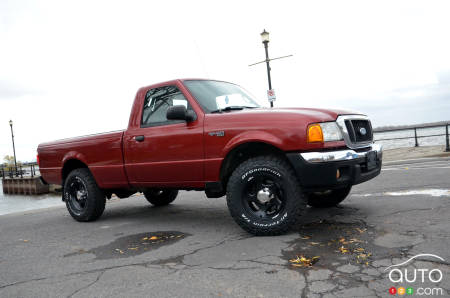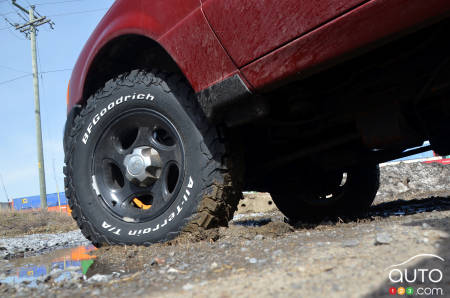Last fall, I bought this 2004 Ford Ranger XLT - a model I quite like, I must admit. There were the expected adjustments and fixits to be made on things under the hood of an older used vehicle, but after that, I understood in short order that the tires installed on the vehicle were not suited for this pickup. Though brand-new, the off-road tires were simply too big. I decided to go back to basics with a set of OEM-sized off-road tires calculated to fit by Ford’s own engineers.
See also: BFGoodrich T/A K02 Tires Review, Part 1: All-Terrain Tires, All Year ‘Round? Discuss
Winter-approved off-road tires?
I turned to BFGoodrich for tires to to wrap around the 16-inch rims of my latest toy. The T/A K02 tires, despite their modern design, seemed like a strong option given the type of use I was planning to make of this old-timer truck. You see, my job as an automotive journalist requires me to drive several vehicles a month, but occasionally, I like to sit behind the wheel of an unsophisticated vehicle like the old Ranger, a generation of the truck sold on the market until 2011.
Let’s be honest: Compared to modern vehicles, this truck really doesn't have obvious qualities going for it: it suffers from questionable comfort, poor fuel economy, basic equipment, so-so handling, etc, etc. On the other hand, this simple truck has the advantage of far less cocoonish than a luxury SUV. Meaning, you can feel all the imperfections of the road, the wind and, yes, how the tires behave under the weight of the vehicle.
So, I decided to try driving twelve months a year with only one set of tires, since my annual mileage was going to be quite limited anyway. What's the point of having eight tires on two sets of wheels for a vehicle that doesn't get as much use as the everyday car? Plus, I was especially curious to see how the off-road tires would perform in the middle of winter. And it proved quite a test, because our 2021-2022 winter was harsher than average.
Browse cars for sale available near you
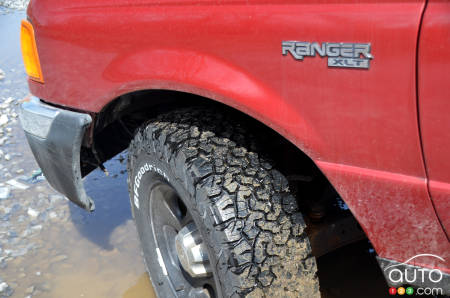
First, on dry roads
My first use of the BFGoodrich T/A K02 tires came in the fall, season for soggy leaves-covered streets and the first sub-zero days. As I mentioned earlier in chapter one in late 2021, the first few kilometres posed no problems; I even found, to my surprise, a quiet ride from the tires, even with their aggressive design. Of course, low-resistance tires do much better, but when you consider the all-purpose nature of this tire, it's quite surprising that these are so smooth on pavement.
The fact that they are winter-approved also explains why the tires stuck quite well to the road during those first few days of cold weather. It's true that if you push a little in 2WD mode and with absolutely nothing in the cargo box, you can spin the rear tires quite easily, but this was in a truck with few modern safety systems installed. In any case, these slight spinning sessions put a smile on my face.
On snow, ice and asphalt in winter
As it happened, it took two weeks between my first dry ride in the fall and my first contact with a slippery snow-and-ice covered surface in December. I noticed right away that the grip was a little less biting in that context, though it was so slight that I’d still wager it was a figment of my imagination. Besides, it’s always dangerous to give an opinion after only a few kilometres. Clearly, I hadn't seen anything yet!
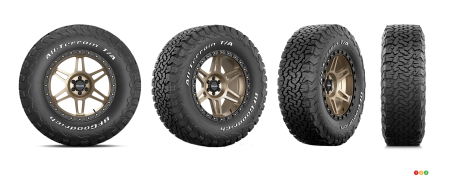
Fortunately for my winter driving project, the white stuff that covers our roads for a few months every year made itself quite at home in the first two months of 2022. I would get plenty of opportunities to determine if winter-rated off-road tires could replace two sets of tires, one for winter and one for non-winter.
I discovered, for instance, that a pickup equipped with such tires and parked on an ice-covered driveway will struggle backing up in two-wheel drive. No matter how gentle I was with the throttle, the vehicle just wouldn’t move. No worries, a simple switch to 4WD solved my problem. In fact, I almost felt like I had suction cups under my tires because the vehicle was so good at biting down on the icy incline. Later, I intentionally got myself stuck in a snowbank after reverting the Ranger back to 2WD mode. As soon as I flipped back to 4WD, my pickup pulled out of the snowbank as if it wasn’t even there.
Of course, these tires lacked that fine grip that only true winter tires can achieve when it's very cold, but overall, the set of K02s certainly impressed me for its general winter behavior, its neutrality and that "grip", courtesy of the K02's studs.
And after the K02?
It will be interesting to see how the market reacts to this new trend of adventure vehicles, as manufacturers fit the most robust versions with all-terrain tires. The BFGoodrich T/A K02 already features CoreGuard technology, a technology borrowed from the Baja T/A KR2 tires used in desert racing. The sidewalls of the K02 are 20-percent stronger than the previous model, the K0. The rubber is also thicker for this generation of the off-road tire.
In addition, it seems that the tread design (with interlocking tread elements) has helped greatly in biting into the various surfaces that have been used over the past few months.
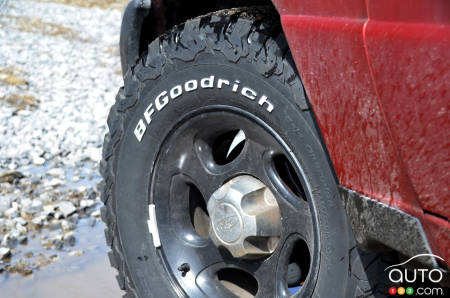
This new model called Trail Terrain T/A seems like a softer option for SUV and CUV owners. This new model is exactly what small truck owners will aim for when they need to replace the OEM set on their vehicle. We’ll keep those for a future tire review, because well, for now, these T/A K02s are just fine for what I intend to do with this old truck.
